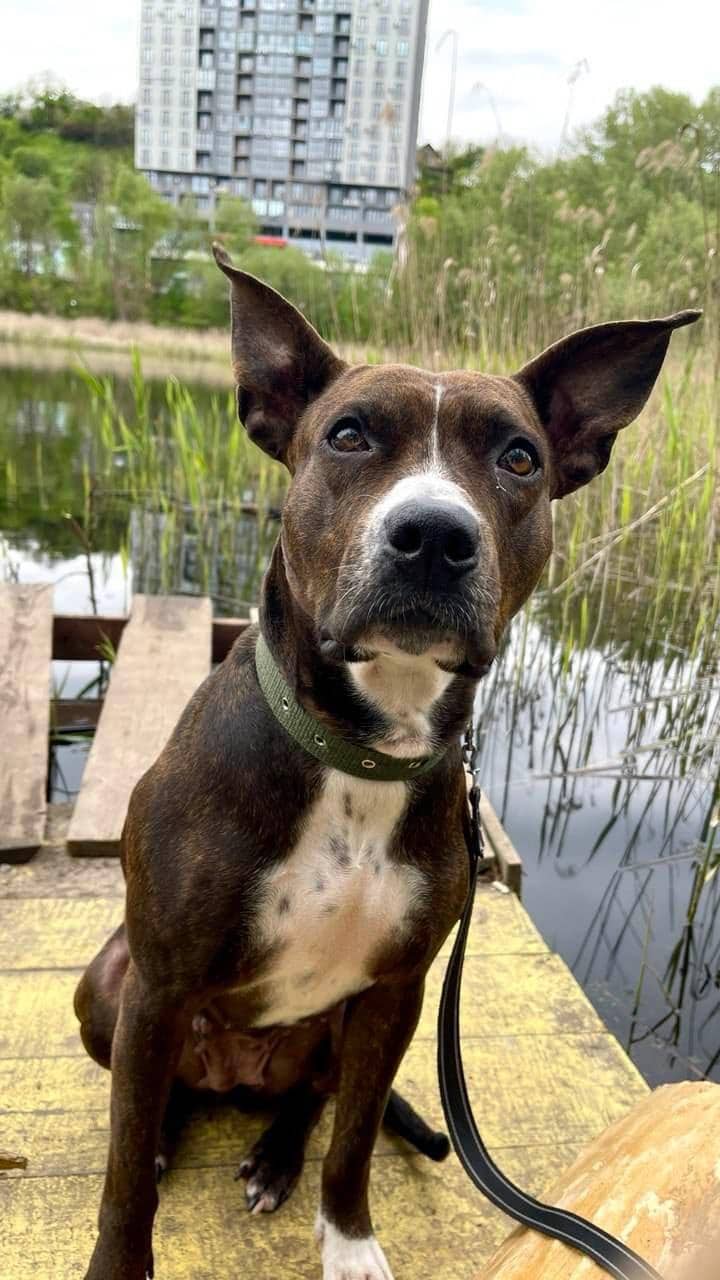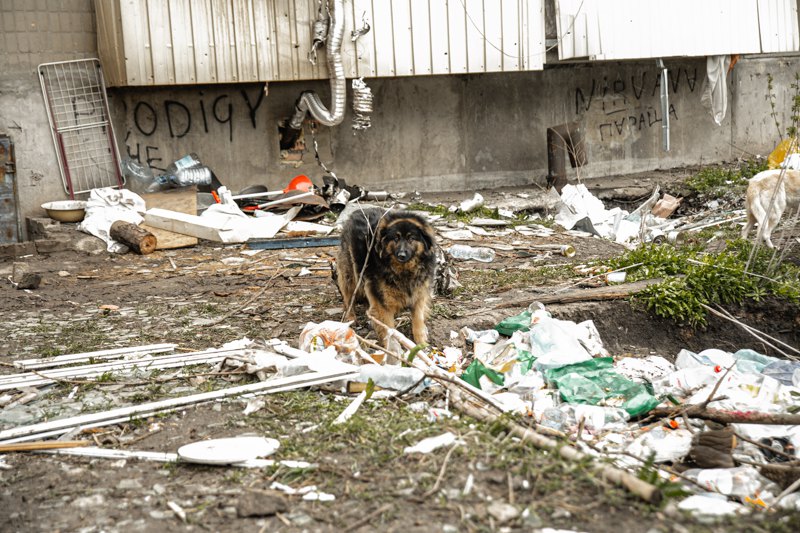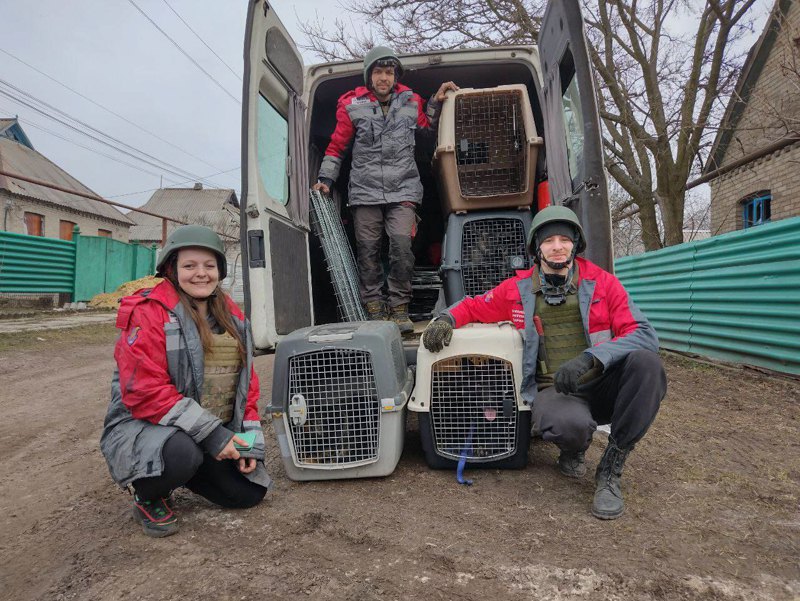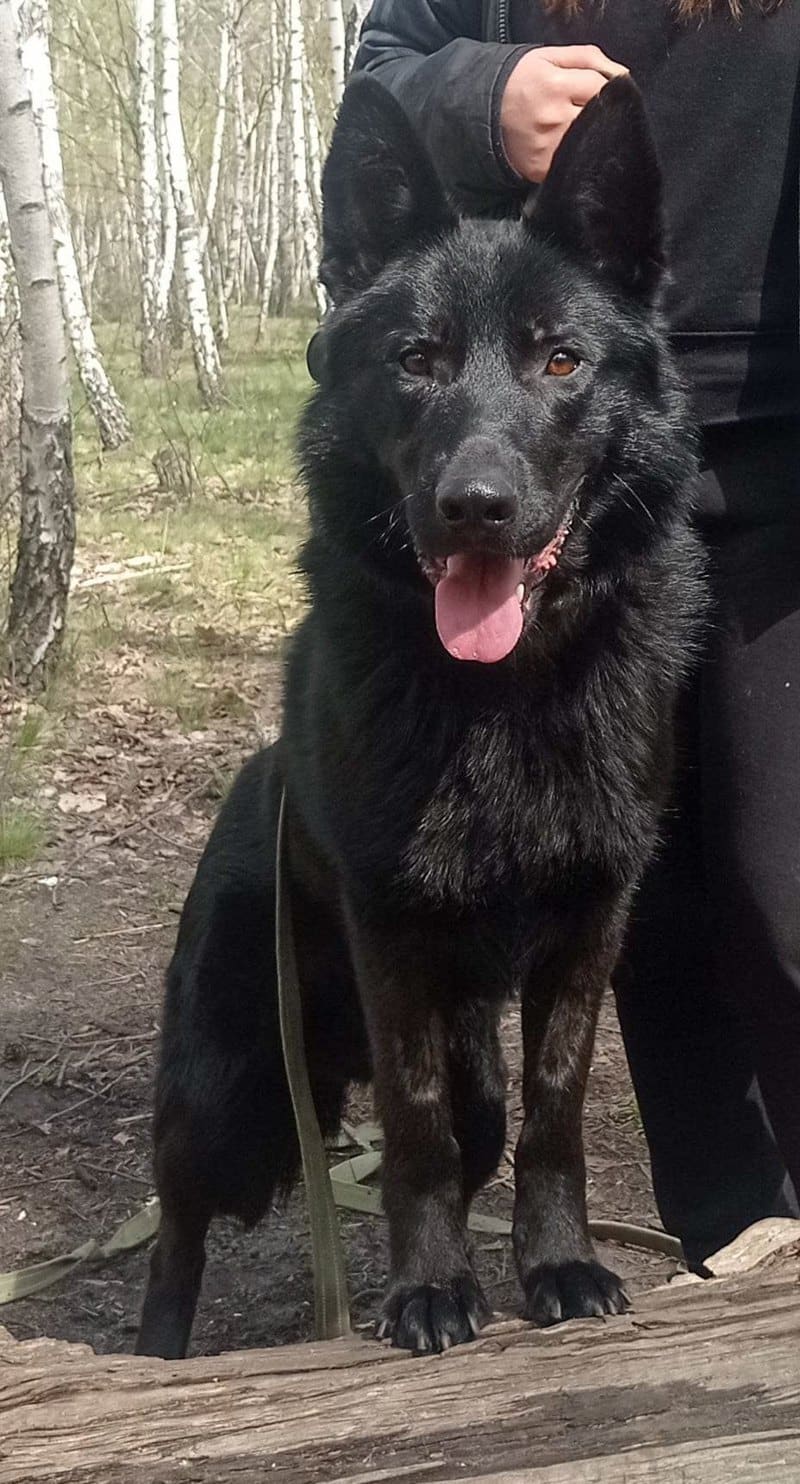Mykhailo and Lyuba were walking across a broken bridge. Back in January, the temperature dropped to — 18°. And the ice held the pieces together like cement. A month ago, Zabakhmutka could be reached by car, but now it’s no longer possible.
The day before, when they were looking for a way to the most shelled area of Bakhmut, the military warned them that they could not go there. A local man persuaded Misha: “Brother, I’m begging you, don’t go there. Half an hour ago, 20 or 30 shells hit the crossing.” And then, at the unbreakable point, a man from there came up to them and said that there was a dog, a pit bull named Alpha, and a cat that needed to be taken out.
That’s how the three of them ended up on that destroyed bridge.
Alpha from Bakhmut
Lyuba Golubeyeva was preparing for an evacuation mission to Bakhmut with her colleagues from Kyiv Animal Rescue, but rather as a fellow traveler. She wanted to visit her husband, who was a soldier. However, it didn’t happen that way — her husband was killed. Eventually, Lyuba decided to go to the east anyway. She explains that she didn’t want to sit at home mourning but wanted to do something. “Doing something” meant rescuing animals from there.
“The first time was a bit scary when we put on body armor near Bahmut,” she recalls. “Then we entered the city, and there was such an atmosphere: a small market was operating, a tank was driving nearby, explosions could be heard in the distance, and locals were walking around. I saw them, and I felt calmer.”
The owner of pit bull Alpha died during the shelling. A shell hit his yard when he was outside. He was buried there in the yard. A neighbor took the dog in and looked after it until rescuers from Kyiv Animal Rescue came to Bakhmut.
Source: Lyuba Golubeyeva
Lyuba led Alpha on a leash all the way from Zabakhmutka to the place where they left the car. The dog didn’t resist and obediently got into the car. They even allowed dog into the house where the mission participants were staying. Alpha and Lyuba slept on the floor on a sleeping mat, covered with a single sleeping bag.
“It was very affectionate to everyone. Such a cuddly dog,” Lyuba smiles. “I sent Alpha’s photo to my mother-in-law. We live together. She asked if we took a big risk when we rescued Alpha. I said, ‘Very much so.'”
In response, she received: “Then bring it home.” That’s how Alpha ended up in Kyiv. It still fears loud noises and gets scared, for example, at the sound of a truck rumbling. When Alpha sleeps, it sometimes whimpers, and other times barks. But it has people give love.
“Of course, I have no regrets about anything. We often say that it was fate, and the dog was meant for us. That’s how it all worked out. And Alpha brings some joy to my mother,” says Lyuba. “I feel so sorry for the animals from there. Their stories, for me, are stories about the indifference of some and the humanity of others.”
That time, Lyuba and Mykhailo made another attempt to rescue other animals from Zabakhmutka. But they narrowly avoided getting caught in a crossfire. It turned out they were heading straight towards Russian positions.
Rescue under fire
At the end of April, Mykhailo Storozhuk, a rescuer from Kyiv Animal Rescue Group, was surveying the bombed-out houses on a street in Chasiv Yar. A dog was barking, clearly trying to get his attention. When it was sure he noticed it and started following, the dog ran a little ahead. It looked back, made sure the person wasn’t falling behind, barked again, and ran further. The dog led Mykhailo to a shattered house. There, on a bed, lay another exhausted dog.
“We rescue whoever we can,” says Mykhailo. “An emergency situation is an emergency situation, and we are ready to work. Going to the combat zone and operating there is one of the challenges for our team.”
In December of last year, a person reached out to them, asking for help in evacuating 20 dogs from Bahmut. That’s where it all began, actually. The first trip was considered a trial run — they needed to orient themselves on-site, figure out what can be done, what can’t, and how to organize subsequent missions. At that time, volunteers accompanied the team, as they were evacuating people from Bahmut. They showed them how it’s done, where the shots were coming from, where Russian troops were positioned, and which streets to avoid. During the first mission, they managed to rescue 36 animals. After that, the team worked independently until urban fighting broke out in Bahmut. Following that, the rescuers focused their efforts on Chasiv Yar.
“For the first time, I saw Bahmut already half-destroyed. And the situation in Chasiv Yar went from being normal to horrific right before our eyes,” Mykhailo recounts. “You see a building, and in the next mission, that building is already bombed, and then there are no remnants left, it’s filled with water and that’s it. They say a shell doesn’t hit the same place twice. It does, and how.”
For the second trip to the east, the team prepared with a clear purpose. They raised funds for a large van because a small vehicle wouldn’t suffice — there were too many animals. They searched for body armor and helmets, purchased medications, gathered first aid kits, carriers, and food. They underwent a tactical medicine course to understand how to behave in case of injuries.
Source: Lyuba Golubeyeva
Requests for the evacuation of some animals came from owners who had left the city. They learned about others in need of assistance on-site. For example, in Bahmut, the unbreakable point became an information hub. People would come there and share information about who and where needed to be rescued, or they would bring animals for evacuation.
See also: A source of non-knowledge: the history of Ukraine in European school textbooks
We had to see and hear a lot.
“Before leaving the city, a woman put her dogs and cats to sleep — she couldn’t take them with her, but she didn’t want to abandon them on the street. The next day, when she left, nothing was left of her house,” says Mykhailo.
Another family miraculously escaped from Zabakhmutka when it became impossible to reach it by transport means. They walked 5 km under shelling and carried their cat in a box.
A woman from Chasiv Yar had prepared in advance for departure. When the evacuation was announced in the city, she brought a truck, packed her belongings, took her own cats, and all the cats from neighboring houses — more than twenty in total. She didn’t have enough carriers, so she placed them in cardboard boxes and left. She had to leave behind five stray cats that scattered. However, the neighbors later caught them, and she contacted us to have them evacuated.
“More conscious individuals took their pets with them during the evacuation. Less conscious ones would simply release them on the street or give their house keys to neighbors to take care of them. And it’s hardest for pets that suddenly find themselves on the street, which they are not used to. For these animals, war is probably about betrayal, first of all. And for the homeless, it is about hopelessness, about the impossibility of existing any longer,” says Mykhailo.
Since December, participants of Kyiv Animal Rescue have carried out five evacuation missions to Bahmut and Chasiv Yar. In one of them, they came under mortar fire and miraculously escaped with only shattered glass in the car. They evacuated over four hundred dogs and cats from there, along with ducks, roosters, goats, chinchillas, and parrots. They say it’s just a drop in the ocean. You can’t save everyone, no matter how much you want to.
“Not everyone can fit in the van. Some have to be left behind. And it’s very difficult,” admits Mykhailo.
Source: Fiyka
While cats are easier to evacuate, dogs are a different story. People left behind a lot of large caged animals, which cannot be easily taken into evacuation vehicles. To rescue them, each dog requires a separate cage, which could accommodate a dozen cats. And finding suitable arrangements for the dogs later is also more challenging.
The house of 12 cats
At first, it ran after their van for two blocks. Then there was a road that tank tracks had turned into a mess. The car stopped, and from there it was only on foot. “Will you come with us to distribute food?” Fiyka looked into the dog’s dark eyes. It obediently nodded and followed along. “You’re such a clever one, and handsome too.” She asked Mykhailo aloud: “Maybe we can take it with us? Someone will surely take it in.”
In the end, she herself took him in. The mixed-breed dog from Chasiv Yar turned out to be a black German Shepherd. It has been living in Kyiv with its new family for over a month now. They named it Vovchok. Because, on one hand, the dog resembles a little wolf, and on the other hand, it is a true mischief-maker.
“I never expected it myself. It would have made sense if I had brought a cat,” Fiyka smiles. “But I always wanted a black male dog, resembling a wolf. And here it came straight to me just as I had wished. So, I guess that’s why I took it in.”
Gradually, Vovchok is adapting to new life, getting acquainted with new people and other dogs, with the help of a dog trainer.
Source: Fiyka
“It is very kind and playful, but uncontrollable. The dog knocks everything around, trips over itself, and doesn’t listen. It’s challenging. It can’t focus on anything, constantly switching from one thing to another in a second. This is how post-traumatic stress disorder manifests. And if someone takes a dog from the combat zone, they should understand that they will need to work with it. This applies to all animals. Because such a dog will not be 100% stable. Some are calmer because they are fearful. Some are like Vovchok. Some are aggressive. Each of them experiences stress and their own trauma differently: being left behind, losing their owners, everything exploded. They have been through a lot of negative experiences and require rehabilitation. Cats also go through this dramatically, but their experiences are less noticeable to humans,” explained Fiyka.
Mykhailo says that almost all the participants of the missions have taken a dog from the east back home with them. For example, he now has a dog named Sonya, who resembles a spaniel.
Fiyka joined the evacuation trips of Kyiv Animal Rescue in March.
“There are many people there who rescue humans. And I love animals very much. They also deserve to live. By working together, we can accomplish a lot. There is nothing impossible,” Fiyka explains her motivation.
It was impossible to get to Bakhmut at that time, so the team headed to Chasiv Yar. They were accompanied by a veterinarian who helps the locals. He immediately showed them his bus, which had been pierced by a shrapnel: “It happens there all the time. Are you sure you need to go there?
“When we turned from the highway into the city, it felt like a movie. Two cargo helicopters flew, smoke was pouring out from smike grenades, and explosions everywhere. You see a half-destroyed high-rise building, and next to it, there’s a generator and a StarLink antenna in a trash bag. And it’s like that everywhere — devastation, StarLink antennas, generators. And there’s a little shop where a man sells kebabs for 500 hryvnias for a skewer and vodka. Everything is formed by these contrasts. For example, a man rides a bicycle, and behind him, there’s a tank with a pack of dogs running. That’s actually how we first saw the animals. When we had just arrived, it seemed like there were no animals there at all,” says Fiyka.
If animals in Bahmut were more sociable, in Chasiv Yar, they were often more feral. Dogs mainly roam the city in packs. In the Canal area, the most dangerous district, most cats are traumatized and in critical condition due to constant explosions. It’s difficult to lure them because they can’t hear. Many animals are malnourished and exhausted.
“Cats weigh as light as a feather and are afraid of open spaces,” says Fiyka. “Of course, there are people in the city who feed them, either the military or locals. There aren’t many locals taking care of animals, but they are visible and steadfast.”
Like Tanya, for example. Since 2014, she has been rescuing abandoned and injured animals from everywhere. She takes care of their treatment, sterilization, and finding them homes. She stays at home, although her street is almost empty now. She currently has over 20 dogs. There used to be 20 cats too, but they have already been taken away by volunteers.
“We can’t take all the dogs from her because there’s not enough space. We take a few of them on each mission — the ones with the best chances of finding homes or the most injured ones. I once asked her, ‘If all the animals are taken away, will you leave?’ She said, ‘If everyone goes, then yes.’ But you understand that it’s impossible,” says Fiyka.
They stumbled upon this house by chance. They had an address where they were asked to pick up two cats. When they arrived at the location, they found out that the house had been bombed, as well as the neighboring one. And the cats were running into another house across the road.
“We called it ‘House of the 12 cats’ because as soon as we entered, about a dozen animals came rushing towards us and scattered,” Fiyka tells.
She told her team that she wouldn’t leave until she caught them all. It took two packets of wet food and over an hour to accomplish that.
The animals from the “House of the 12 cats” were being fed by an elderly woman who lived nearby. That’s why the cats stayed there. Initially, she brought them milk and fish while they were there. Then she cooked “some red porridge” from humanitarian aid, and eventually, their diet was reduced to just bread.
“It’s impossible to buy proper food there, and these cats suffer because of it. If no one brings them food, people feed them with whatever they have themselves, and they eat very poorly. And let’s not forget that these are animals accustomed to care — and they’re not receiving it. Poor nutrition leads to illness. As a result, they become vulnerable to larger animals. In addition, they continue to reproduce. So, not only do they suffer from this difficult life but also their offspring,” explains Fiyka.
Her phone gallery is full of photos. Here are dead dogs, which their owners left locked in the territory while they left. This is a cat, it came to my grandmother wounded. She nursed it back to health. And when the rescuers took it away, it resisted a lot, and then did not trust anyone for a long time. Another photo is another story, and there are an incredible number of them.
“And every animal we missed is a personal tragedy for me because there are very, very few chances of survival there,” says Fiyka.
Finding a new home
In Kyiv, Alicia Polikha receives cars with animals. Without her, everything would have ended very quickly — after the first mission. Because you can take out animals endlessly. On the contrary, the possibilities to find good hands for the brought animals are very limited.
“We rescue animals from emergency situations. This is our profile. We are the Ministry of Emergency Situations. We hardly ever rehome them. From time to time, if an animal did end up with us, we would look for a new home for it. But this was definitely not our strong point, especially considering it wasn’t our main focus,” explains Alicia Polikha.
However, you have to do it if you want to. The team has been learning to adapt to and respond to the circumstances since the beginning of the full-scale invasion. It was a difficult period for Kyiv Animal Rescue.
“Many people were essentially left behind. Some joined the military, some were on vacation abroad at that time, and a girl joined the territorial defense. Out of the entire team, only the three main rescuers remained working,” Alicia explains.
She was one of the three. She says she didn’t even consider leaving Kyiv. Her biggest fear was that something would happen to her house while she wasn’t there. So she attached a note to every door in her apartment, stating: “Five cats live here.”
“So that they would know how many to look for,” adds Alicia.
And then she would simply change the number on the note: sometimes to “6,” sometimes to “7,” depending on the changing number of cats in the house.
Then the main task became finding food for shelters and volunteers who had animals in their care. They would buy food and distribute it to those in need. They would stand in long lines at pet stores and warehouses as soon as they started to open. And they constantly replenished this supply.
“If before we used to have seven calls a day, then it decreased to just one. Instead, there were ten deliveries of food. It felt like if you didn’t accomplish anything during the day, you wasted it, even though we were barely getting by. The most painful issue was animals locked in apartments. But due to the lack of resources, we couldn’t respond to such calls. We had a group of volunteers in our chat who self-organized and took on that piece of work. And in this way, we were more effective than if we had tried to handle everything ourselves,” says Alicia.
Since then, Kyiv Animal Rescue has long returned to its usual number of calls. However, the team currently doesn’t have the opportunity to carry out evacuation missions more frequently than once a month. This is due, on the one hand, to limited human resources primarily. On the other hand, it is related to the capacity of shelters and volunteers available to take in animals from missions for temporary care.
“Very often, people who collaborate with us on a regular basis manage to treat and find homes for their own animals within a month. This means that they free up space. And they can take in someone else again,” explains Alicia.
Source: Fiyka
She recalls how the day before the first trial trip to the east, she was questioning familiar volunteers about how many animals they could accommodate. She made notes: “they can take 5 dogs up to 10 kg,” “they can take a few up to 5.” And then, within two weeks, when they finally managed to go to Bachmut, all those agreements fell through one after another.
See also: How Ukrainian museums survive during the great war
“Because some people had already found animals to take care of on their own. Some were brought by someone from Sloviansk, others were handed over by the military from Bachmut. The influx of animals is so large that it’s impossible to reserve spaces for them,” says Alicia. “And I realized that we need to do everything based on the actual availability of the animal. Our team members would take photos, send them to the chat, write down the gender and size. Meanwhile, I would think about who would be the best fit for that particular animal. Some specialize in small dogs, others prefer only the heaviest ones, and some, for example, are interested in the least popular еortoiseshell cats or black and white cats. And that’s how it all started.”
Kyiv Animal Rescue tries not to collaborate with large shelters that have many animals in order to avoid burdening them unnecessarily. Instead, they interact with either mini-shelters or volunteers who, through veterinary clinics, conduct examinations of dogs and cats, provide necessary medical treatment, and then either foster them or find new owners for them.
I’m not the kind of person who sits in the background. That’s just not me. I need to be in the thick of things — climbing somewhere, rescuing someone, like Bruce Willis,” Alicia says with a smile, recalling how last spring she climbed a lamppost to free a crow that was trapped in its structure.
“The taxi driver who brought me there probably thought I was in a very sad state,” she laughs. “And here I am, sitting with a notepad on my phone, shuffling cats. Not exactly thrilling. You can only do something like this out of great love.”
Of course, it’s for the animals. As for people, Alicia mostly has an ironic attitude. It comes with the territory of her work.
“The war came, and you would think that some perspective would change. But in reality, no,” she says, sharing a recent story.
The team recently received a call: a cat was trapped in a window for ventilation. The owner was not home. Usually, to rescue such animals, the rescuers attach a rope from above and descend down. But this time, the neighbor on the floor above didn’t allow it from their apartment. Fair enough, says Alicia. However, he also refused to let them cut the lock on the roof to reach the animal.
“We eventually managed to save the cat. But certainly not thanks to the neighbor. And this is happening right now in Kyiv, which is not occupied, where life goes on. There are millions of people here, and they pass by without noticing. But in the front-line territories, it’s even worse. I understand perfectly well that people in the conflict zone have other priorities than animals. There is a small percentage of those who look after them, but with limited resources, it’s physically impossible to help everyone. But those animals are no less deserving, they also need help. And if there is an opportunity, it should be done,” concluded Alicia.
Originally posted by Olena Struk on LB. ua. Translated and edited by the UaPosition – Ukrainian news and analytics website





